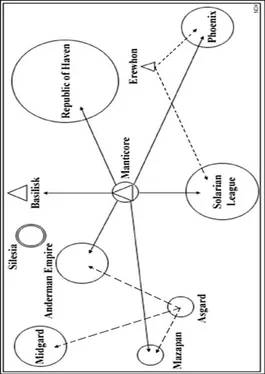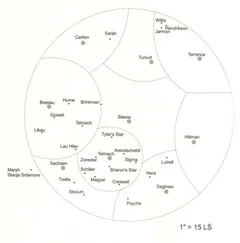David Weber - On Basilisk Station
Здесь есть возможность читать онлайн «David Weber - On Basilisk Station» весь текст электронной книги совершенно бесплатно (целиком полную версию без сокращений). В некоторых случаях можно слушать аудио, скачать через торрент в формате fb2 и присутствует краткое содержание. Жанр: romance_sf, на английском языке. Описание произведения, (предисловие) а так же отзывы посетителей доступны на портале библиотеки ЛибКат.
- Название:On Basilisk Station
- Автор:
- Жанр:
- Год:неизвестен
- ISBN:нет данных
- Рейтинг книги:5 / 5. Голосов: 1
-
Избранное:Добавить в избранное
- Отзывы:
-
Ваша оценка:
- 100
- 1
- 2
- 3
- 4
- 5
On Basilisk Station: краткое содержание, описание и аннотация
Предлагаем к чтению аннотацию, описание, краткое содержание или предисловие (зависит от того, что написал сам автор книги «On Basilisk Station»). Если вы не нашли необходимую информацию о книге — напишите в комментариях, мы постараемся отыскать её.
On Basilisk Station — читать онлайн бесплатно полную книгу (весь текст) целиком
Ниже представлен текст книги, разбитый по страницам. Система сохранения места последней прочитанной страницы, позволяет с удобством читать онлайн бесплатно книгу «On Basilisk Station», без необходимости каждый раз заново искать на чём Вы остановились. Поставьте закладку, и сможете в любой момент перейти на страницу, на которой закончили чтение.
Интервал:
Закладка:
The answer to that one had been the hyper log, the interstellar equivalent of the ancient inertial guidance systems developed on Old Earth long before the Diaspora. Early-generation hyper logs hadn't been all that accurate, but they'd at least given astrogators a rough notion of where they were. That had been far better than anything that had come before, yet even with the hyper log, so many ships never returned that only survey vessels used hyper space. Survey crews had been small, fantastically well-paid, and probably just a bit crazy, but they'd kept hyper travel in use until, eventually, one or two of them encountered what had killed so many other starships and survived to tell about it.
Hyper space itself was best considered as a compressed dimension which corresponded on a point-by-point basis to normal space but placed those points in much closer congruity and so "shortened" the distance between them. In fact, there were multiple "bands," or associated but discrete dimensions, of hyper space. The "higher" the band, the shorter the distance between points in normal space, the greater the apparent velocity of ships traveling through it . . . and the higher the cumulative energy cost to enter it.
That much had been understood by the earliest theorists. What they hadn't quite grasped was that hyper space, formed by the combined gravitational distortion of an entire universe's mass, was itself crossed and crisscrossed by permanent waves or currents of focused gravity. They were widely separated, of course, but they also might be dozens of light-years wide and deep, and they were deadly to any ship which collided with one. The gravitational shear they exerted on a starship's hull would rip the hapless vessel apart long before any evasive action could even be contemplated, unless the ship happened to impact at precisely the right angle on exactly the right vector, and its bridge crew had both the reflexes and the reaction mass to wrench clear in time.
As time passed, the survey ships that survived had mapped out reasonably safe routes through the more heavily traveled regions of hyper space. They couldn't be entirely relied upon, for the grav waves shifted position from time to time, and sticking to the safe lanes between waves often required vector changes reaction-drive ships simply could not make. That meant hyper voyages had tended to be both indirect and lengthy, but the survival rate had gone up. And as it climbed, and as physicists went out to probe the grav waves they now knew existed with ever more sophisticated instruments, observational data increased and ever more refined theories of gravity were proposed.
It had taken just over five hundred years, but finally, in 1246 P.D., the scientists had learned enough for the planet Beowulf to perfect the impeller drive, which used what were for all intents and purposes "tame" grav waves in normal space. Yet useful as the impeller was in normal space, it was extraordinarily dangerous in hyper. If it encountered one of the enormously more powerful naturally occurring grav waves, it could vaporize an entire starship, much as Honor herself had blown the Havenite courier boat's impeller nodes with Fearless's impeller wedge.
More than thirty years had passed before Dr. Adrienne Warshawski of Old Earth found a way around that danger. It was Warshawski who finally perfected a gravity detector which could give as much as five light-seconds' warning before a grav wave was encountered. That had been a priceless boon, permitting impeller drive to be used with far greater safety between grav waves, and even today all grav detectors were called "Warshawskis" in her honor, yet she hadn't stopped there. In the course of her research, she had penetrated far deeper into the entire grav wave phenomenon than anyone before her, and she had suddenly realized that there was a way to use the grav wave itself. An impeller drive modified so that it projected not an inclined stress band above and below a ship but two slightly curved plates at right angles to its hull could use those plates as giant, immaterial "sails" to trap the focused radiation hurtling along a grav wave. More than that, the interface between a Warshawski sail and a grav wave produced an eddy of preposterously high energy levels which could be siphoned off to power a starship. Once a ship had "set sail" down a grav wave, it could actually shut down its onboard power plants entirely.
And so the grav wave, once the promise of near certain death, had become the secret to faster, cheaper, and safer hyper voyages. Captains who had avoided them like the plague now actively sought them out, cruising between them on impeller drive where necessary, and the network of surveyed grav waves had grown apace.
There had still been a few problems. The most bothersome was that grav waves were layers of focused gravity, subject to areas of reverse flow and unpredictable bouts of "turbulence" along the interfaces of opposed flows or where one wave impinged upon another. Such turbulence could destroy a ship, but it was almost more frustrating that no one could take full advantage of the potential of the Warshawski sail (or, for that matter, the impeller drive) because no human could survive the accelerations which were theoretically possible.
Improved Warshawskis had tended to offset the first difficulty by extending their detection range and warning ships of turbulence. With enough warning time, a ship could usually trim its sails to ride through turbulence by adjusting their density and "grab factor," though failure to trim in time remained deadly, which was why Sirius's claim of tuner flutter had been so serious. A captain still had to see it coming, but the latest generation detectors could detect a grav wave at as much as eight light-minutes and spot turbulence within a wave at up to half that range. The problem of acceleration tolerance, on the other hand, had remained insoluble for over a standard century, until Dr. Shigematsu Radhakrishnan, probably the greatest hyper physicist after Warshawski herself, devised the inertial compensator.
Radhakrishnan had also been the first to hypothesize the existence of wormhole junctions, but the compensator had been his greatest gift to mankind's diaspora. The compensator turned the grav wave (natural or artificial) associated with a vessel into a sump into which it could dump its inertia. Within the safety limits of its compensator, any accelerating or decelerating starship was in a condition of internal free-fall unless it generated its own gravity, but the compensator's efficiency depended on two factors: the area enclosed in its field and the strength of the grav wave serving as its sump. Thus a smaller ship, with a smaller compensator field area, could sustain a higher acceleration from a given wave strength, and the naturally-occurring and vastly more powerful grav waves of hyper space allowed for far higher accelerations under Warshawski sail than could possibly be achieved under impeller drive in normal space.
Even with the acceleration rates the compensator permitted, no manned vessel could maintain a normal space velocity above eighty percent of light-speed, for the particle and radiation shielding to survive such velocities simply did not exist. The highest safe speed in hyper was still lower, little more than .6 c due to the higher particle charges and densities encountered there, but the closer congruity of points in normal space meant a ship's apparent velocity could be many times light-speed. Equipped with Warshawski sails, gravity detectors, and the inertial compensator, a modern warship could attain hyper accelerations of up to 5,500 g and sustain apparent velocities of as much as 3,000 c . Merchantmen, on the other hand, unable to sacrifice as much onboard mass to the most powerful possible sails and compensators the designer could squeeze in, remained barred from the highest hyper bands and most powerful grav waves and were lucky to make more than 1,200 c , though some passenger liners might go as high as 1,500.
Читать дальшеИнтервал:
Закладка:
Похожие книги на «On Basilisk Station»
Представляем Вашему вниманию похожие книги на «On Basilisk Station» списком для выбора. Мы отобрали схожую по названию и смыслу литературу в надежде предоставить читателям больше вариантов отыскать новые, интересные, ещё непрочитанные произведения.
Обсуждение, отзывы о книге «On Basilisk Station» и просто собственные мнения читателей. Оставьте ваши комментарии, напишите, что Вы думаете о произведении, его смысле или главных героях. Укажите что конкретно понравилось, а что нет, и почему Вы так считаете.












